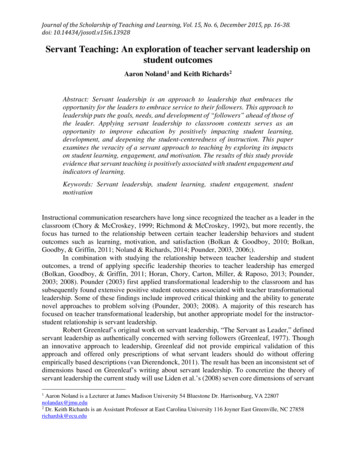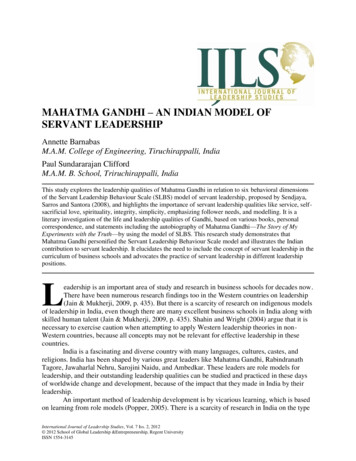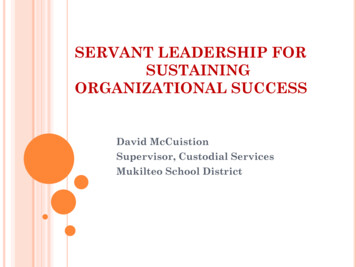
Transcription
Journal of the Scholarship of Teaching and Learning, Vol. 15, No. 6, December 2015, pp. 16-38.doi: 10.14434/josotl.v15i6.13928Servant Teaching: An exploration of teacher servant leadership onstudent outcomesAaron Noland 1 and Keith Richards 2Abstract: Servant leadership is an approach to leadership that embraces theopportunity for the leaders to embrace service to their followers. This approach toleadership puts the goals, needs, and development of “followers” ahead of those ofthe leader. Applying servant leadership to classroom contexts serves as anopportunity to improve education by positively impacting student learning,development, and deepening the student-centeredness of instruction. This paperexamines the veracity of a servant approach to teaching by exploring its impactson student learning, engagement, and motivation. The results of this study provideevidence that servant teaching is positively associated with student engagement andindicators of learning.Keywords: Servant leadership, student learning, student engagement, studentmotivationInstructional communication researchers have long since recognized the teacher as a leader in theclassroom (Chory & McCroskey, 1999; Richmond & McCroskey, 1992), but more recently, thefocus has turned to the relationship between certain teacher leadership behaviors and studentoutcomes such as learning, motivation, and satisfaction (Bolkan & Goodboy, 2010; Bolkan,Goodby, & Griffin, 2011; Noland & Richards, 2014; Pounder, 2003, 2006;).In combination with studying the relationship between teacher leadership and studentoutcomes, a trend of applying specific leadership theories to teacher leadership has emerged(Bolkan, Goodboy, & Griffin, 2011; Horan, Chory, Carton, Miller, & Raposo, 2013; Pounder,2003; 2008). Pounder (2003) first applied transformational leadership to the classroom and hassubsequently found extensive positive student outcomes associated with teacher transformationalleadership. Some of these findings include improved critical thinking and the ability to generatenovel approaches to problem solving (Pounder, 2003; 2008). A majority of this research hasfocused on teacher transformational leadership, but another appropriate model for the instructorstudent relationship is servant leadership.Robert Greenleaf’s original work on servant leadership, “The Servant as Leader,” definedservant leadership as authentically concerned with serving followers (Greenleaf, 1977). Thoughan innovative approach to leadership, Greenleaf did not provide empirical validation of thisapproach and offered only prescriptions of what servant leaders should do without offeringempirically based descriptions (van Dierendonck, 2011). The result has been an inconsistent set ofdimensions based on Greenleaf’s writing about servant leadership. To concretize the theory ofservant leadership the current study will use Liden et al.’s (2008) seven core dimensions of servant1Aaron Noland is a Lecturer at James Madison University 54 Bluestone Dr. Harrisonburg, VA 22807nolandax@jmu.edu2Dr. Keith Richards is an Assistant Professor at East Carolina University 116 Joyner East Greenville, NC 27858richardsk@ecu.edu
Noland and Richardsleadership and apply them to the classroom. This theoretical approach offers both a plurality ofprevious theorizing about servant leadership (Barbuto & Wheeler, 2006; Greenleaf, 1977, 1998;Spears, 1998) and an empirically based operationalization of these seven dimensions. Servantleadership is altruistic leadership done in pursuit of follower development independent of largerself-serving goals (Greenleaf, 1977, 1998; Smith, Montagno, & Kuzmenko, 2004; Stone, Russell,& Patterson, 2004).The purpose of this paper is to explore the relationship between teacher servant leadershipbehaviors and student outcomes. The project is specifically looking to determine if servantteaching behaviors are positively related to student learning, motivation, and engagement.Applying this model of leadership to an instructional context may provide teachers with clearbehaviors they can enact to positively impact student learning, motivation, and engagement.Literature ReviewServant TeachingServant leadership’s emphasis on follower development and service as primary goals make it avaluable approach to teacher leadership. The central tenet of servant leadership is of primaryimportance: “the servant-leader (teacher) is servant first (they must) want to serve, to servefirst” (Greenleaf, 1977, para. 1 & 2). The integrity of this central tenet must be applied to theteacher as servant environment. The servant teacher is focused on education as relational,empowering, and liberating instead of on teaching as a one-way, top – down, authoritarianenterprise (Hays, 2008).Distilling the key attributes or dimensions of servant teaching is important to furtherunderstand servant teaching. First, emotional healing is expressing a concern for student wellbeing and completeness and support during times of struggle. Second, creating value for thecommunity means the teacher recognizes the interdependence of the community and student andworks to inspire students to benefit under-privileged communities. Next, empowering students,emphasizes validating the intrinsic value of the student and helping them generate personal powerto succeed. Fourth, helping students grow and succeed, suggests that teachers provideopportunities for students to engage a personal challenge and develop as a result. Fifth, servantteachers put students first, emphasizing student development above all other goals and elevatingstudent welfare above self. This can manifest in many ways some of which may be alteringpedagogical approaches and assessment methods in response to student needs. Next, servantteachers demonstrate conceptual skills by balancing classroom management, instruction, andvision tasks while assisting students in achieving success. Finally, behaving ethically, embodyinghonesty and integrity in interactions and serving as a role model for students is a key element toservant teaching. Transparency and follow-through help to build trust and honesty establishesethical standards for the classroom and beyond (Drury, 2005; Greenleaf, 1977, 1998; Hays, 2008;Hunter et al., 2013; Liden et al., 2008; Patterson, 2003; Smith et al., 2004; Stone, Russell, &Patterson, 2004; van Dierendonck, 2011).Servant leadership’s potential transferability to teacher leadership is evident in the existingresearch linking servant leadership to high quality leader-member exchanges, positive attitudes,high levels of commitment, and performance (van Dierendonck, 2011). These outcomes manifestin a classroom setting in similar, albeit different, ways. A positive attitude about work is analogousto affective learning, commitment should impact motivation, and performance is analogous toJournal of the Scholarship of Teaching and Learning, Vol. 15, No. 6, December 2015.Josotl.Indiana.edu17
Noland and Richardscognitive learning (Noland & Richards, 2014). However, relative little literature investigates theimpact of servant teaching on student outcomes. Bowman (2005) and Drury (2005) both argue formore scholarship to explore the relationships between servant teaching and student outcomes,namely student learning.Student MotivationStudent motivation is a powerful mediating variable between instructor behaviors and studentoutcomes (Jaasma & Koper, 1999) and thus provides an important variable of study in instructionalleadership. If teacher leaders can positively impact motivation then they are likely to be able toindirectly impact other student outcomes such as learning, but motivation can also function as anoutcome variable (Frymier & Shulman, 1995; Richmond, 1990).Motivation has been conceptualized as a contextual state or more stable trait variable(Frymier & Shulman, 1995). Student state motivation is contingent upon other variables, such asclass topic, and varies across different situations; however, trait motivation is a stable attributereferring to a student’s motivation to perform a specific task (Bolkan & Goodboy, 2011; Frymier& Shulman, 1995). Teachers are well positioned to impact student state motivation through activitylevels in the classroom, inspiration, leadership behaviors, and passion (Bolkan, Goodboy &Griffin, 2011; Morton, Keith, & Beauchamp, 2010). Teacher behaviors such as immediacy, clarity,caring, confirmation, and humor all positively predict student motivation (Comadena, Hunt &Simonds, 2007; Frymier, 1993; Myers, et al., 2014). Richmond (1990) argued that in classinteractions are the best way to improve motivation and deepen student learning experiences asteachers have the ability to increase student state and trait motivation by challenging students andaffirming their growth.The relationship between teacher transformational leadership and student motivation hasbeen demonstrated in studies by Morton, Keith, and Beauchamp (2010) and Pounder (2009).Individualized consideration, an element of transformational leadership focused on treatingfollowers as individuals, significantly predicts student motivation (Noland & Richards, 2014) andis highly correlated with servant leadership (Hunter et al., 2013). Servant teaching focuses first onthe student, providing challenge while affirming and encouraging student development aboveother goals (Greenleaf, 1998; Hays, 2008). Hays (2008) found students with servant teachers weremore empowered, confident, and invested. These interconnected relationships lead to theconclusion that servant teaching should positively impact student motivation.RQ1: Are servant teaching and student motivation correlated?Student LearningAccording to Bloom (1956), student learning can be divided into three different types of learning:cognitive, affective, and/or behavioral. For the purposes of this paper affective and cognitivelearning are of primary concern. Affective learning is the attitude (positive or negative valence)toward learning in a particular context; cognitive learning is concerned with how studentsunderstand and retain information (Bloom, 1956).Cognitive learning, receiving, retaining, and applying new information, is an outcomebased approach to learning (Messman & Jones-Corley, 2001). It is the type of learning that is oftenassessed on exams, writing assignments, and presentations. According to Rodriguez, Plax, andKearney (1996) cognitive learning is the function of a variety of other “inputs” such as studentJournal of the Scholarship of Teaching and Learning, Vol. 15, No. 6, December 2015.Josotl.Indiana.edu18
Noland and Richardsmotivation, teacher immediacy behaviors, and affective learning. This model, confirmed in theirstudy, provides a clear path for positively influencing student cognitive learning. Cognitivelearning is influenced by a host of teacher behaviors such as clarity, caring, confirmation, andaffective learning (Goodboy & Myers, 2008; Frymier, 1993; Sidelinger & McCroskey, 1997;Teven & McCroskey, 1997). Servant teachers are uniquely positioned to leverage conceptual skillsto increase clarity and simultaneously leverage empowerment, healing, and putting students firstto increase caring and confirmation.Affective learning, the attitudinal aspect of learning, varies with task, instructor, and course(Bolkan & Goodboy, 2011; Rodriguez, Plax, & Kearney, 1996; Sidelinger & McCroskey, 1997).Increasing student affective learning is a moderator to increasing student cognitive learning andengagement. The more positive an evaluation of course, content, or instructor the more likelystudents are to show gains in cognitive learning (Rodriguez, Plax, & Kearney, 1996). Teacherbehaviors are particularly impactful in increasing student affective learning. Teacher behaviorssuch as immediacy, organization, engaging delivery, enthusiastic seeking of goals, and positivityuniquely impact student attitudes toward their instructor and course content (Kark, Shamir, &Chen, 2003; Pounder, 2006; Sorensen, 1989). Transformational leadership has shown a significantpositive relationship to affective learning as students with transformational teachers report highlevels of affective learning (Bogler, Caspi, & Roccas, 2013; Noland & Richards, 2014; Pounder,2009).Servant teaching should be positively related to student affective learning as students feelchallenged, supported, are given the affirmation, and are cared for personally (Greenleaf, 1977;Hunter et al., 2013; Liden et al., 2008). The empowering nature of servant leadership along withhealing and servitude should positively impact the affective dimensions of learning as studentsfeel a sense of pride to be associated with their teacher, are encouraged to take an active role in thelearning process, and engage with course content (Bowman, 2005; Drury, 2005; Hays, 2008). Onthe other hand, the trailblazing attributes wherein servant teachers remove barriers to success, andthe use of conceptual skills to increase teacher clarity and organization should increase studentcognitive learning (Greenleaf, 2003; Hays, 2008; Myers, et al., 2014;). As a result, the followingresearch question is offered:RQ2: Are servant teaching and student learning correlated?Student EngagementEngagement in the classroom is made up of a variety of factors (Appleton, Christenson, Kim, &Reschly, 2006; Jimerson, Campos, & Grief, 2003; Krause & Coates, 2008). Some characteristicsof an engaged student are that they are doing the work, following the class rules, being motivated,and participating both in and outside of class (Zyngier, 2008). One important aspect in creating anengaging classroom environment is that both the student and the teacher play a role in the process(Krause & Coates, 2008; Linville, 2014). Engagement helps to predict high quality learning and ispositively related to performance (Carini, Kuh, & Klein, 2006; Fredricks, Blumenfeld, & Paris,2004; Klem & Connel, 2004; Krause & Coates, 2008; Skinner, Furrer, Marchand, & Kindermann,2008).Mazer (2012b, 2013a, 2013b,) found that students who scored highest on emotional andcognitive interest were the most engaged in the classroom and were more likely to think deeplyabout the material. Engaged students are more likely to pay attention, be interested, and embracechallenges compared to those students who are not engaged (Klem & Connel, 2004). In contrast,Journal of the Scholarship of Teaching and Learning, Vol. 15, No. 6, December 2015.Josotl.Indiana.edu19
Noland and Richardsdisengaged students are passive and let external forces influence their involvement in learning(Reeve, et al., 2004). Students who are persistent in their effort to embrace challenges will oftenfind new challenges to be more enjoyable (Skinner, et al., 2008). If the student is prepared theteacher needs to draw out these characteristics by creating course content that is interesting andapplicable to the students (Linville, 2014).In order to increase the likelihood of student engagement, teachers need to pay attention tothe individual differences in their students (Linville, 2014). Teachers who have clear expectations,create a caring environment with positive emotions, and support their students often have studentswho report being engaged (Klem & Connel, 2004; Mazer, 2012a, 2013a; Skinner, et al., 2008).Skinner and colleagues (2008) found that providing support to the students was the most beneficialact that a teacher could do to increase motivation and engagement. Umbach and Wawrzynski(2005) looked specifically at college students and found that challenging students through highercognitive activities was an important aspect to creating an environment where students wereengaged with course material. These challenges led students to be more involved in collaborativeand active learning and students were more likely to interact with their faculty.Faculty members have the opportunity to create an environment and culture that fosterslearning by setting high standards, using active and collaborative assignments, interacting withtheir students, and providing support (Umbach & Wawrzynski, 2005). Research on engagementneeds to further identify and understand the role of educators and students in creating these resultsand how they may vary over time (Fredricks, Blumenfeld, & Paris, 2004; Krause & Coates, 2008;Linville, 2014, Mazer, 2013a). Servant teachers, with the focus on student development andsuccess should positively impact student engagement; thus the following research question isoffered:RQ3: Are servant teaching and student engagement correlated?MethodologyData Collection Procedures and ParticipantsStudents at a large Mid-Atlantic University in their introductory communication course wererecruited using a cloud-based participant management program called SONA Systems.Participation in research studies is a required component of the course. Students create a SONASystem log-in and select studies to complete on their own. Once they decided to participate in thecurrent study they were provided with an informed consent form. After giving consent, they weretaken to an online version of the instrument. The data collection began a few weeks into thesemester and concluded around midterm to ensure student familiarity with course and instructor.Students in the introductory communication course are primarily first year students withsome second year and transfer students. The final results of the survey included 434 participantsfrom a number of different sections of the course. The sample was heavily female (355 females,76 males, 3 did not answer), mostly freshman (355 freshmen, 20 sophomore, 35 juniors, 22seniors), and mostly white (351 white), The survey instructions asked students to think about theirfirst class of the week in an attempt to capture a broad range of disciplines, instructors, and coursesin the sample. The responses indicated a wide range of courses, whose professors were distributedbetween male and female and a variety of races.InstrumentationJournal of the Scholarship of Teaching and Learning, Vol. 15, No. 6, December 2015.Josotl.Indiana.edu20
Noland and RichardsServant Leadership was operationalized using a modified version of the seven factor servantleadership scale created by Liden, Wayne, Zhao, and Henderson (2008). The seven factors are:conceptual skills, empowerment, helping subordinates grow and succeed, putting subordinatesfirst, behaving ethically, emotional healing, and creating value for the community. The originalversion of this instrument asks respondents to select a leader and asks questions such as “He/Sheemphasizes the importance of giving back to the community” (Liden, et al., 2008). To modify thisinstrument for use in instructor-student context the He/She was replaced with “My Teacher.” Somesample questions include the following: “My teacher cares about others’ well-being,” “My Teachertakes time to talk to others on a personal level,” and “My teacher can solve academic problemswith new or creative ideas.” The questions were scored on a 5 point Likert scale with answersranging from 1-never to 5-very often. The complete measure (Appendix A) contained 27 questionswhich captured all seven elements of servant leadership.The measurement literature on servant leadership is mixed as related to its dimensionality.Consensus seems to be building that the best way to analyze servant leadership is as aunidimensional construct composed of the seven elements noted above (Hunter et al., 2013). Inthis study we use servant leadership as a proxy for servant teaching analyzing it both as aunidimensaional construct (overall servant leadership) and by breaking out the seven elements toevaluate which element has the highest explanatory power. To arrive at the overall servant teachingscore the items are summed and averaged. Scoring is the same for each of the seven subscales asthe items corresponding to a particular element are summed and averaged.The overall servant leadership reliability was strong in this study( .96 97.037 SD 18.56). Most of the subscales performed well with only ethics ( .73) and empowering ( .75) falling under .80 (all reliabilities and descriptivestatistics for the scales can be seen in Table 1). The strength of the overall measure is consistentwith the idea that servant leadership may indeed be a unidimensional construct (Hunter et. al,2013).Table 1. Reliability and descriptive statistics for scales in analysis MSDServant Leadership0.96 97.3718.60Conceptual Skills0.86 15.043.13Empowering0.75 14.612.75Subordinates Grow0.87 14.883.18Subordinates First0.87 14.433.22Emotional Healing0.82 13.883.29Creating Value0.90 12.903.70Behaving Ethically0.73 11.622.16Motivation0.88 16.866.83Learning Indicators0.90 25.145.48Affective Learning0.75 51.2311.22Student Engagement0.90 49.919.03Journal of the Scholarship of Teaching and Learning, Vol. 15, No. 6, December 2015.Josotl.Indiana.edu21
Noland and RichardsStudent Learning was measured using both affective and cognitive operationalizations. Tomeasure student affective learning the revised affective learning scale was used. This scale asksstudents to report on their attitudes about the instructor, course content, and course overall (Mottet& Richmond, 1998). Weber, Martin, and Patterson (2001) provided evidence that some of thesubscales were redundant. As a result, this study used the four subscales: course content,appreciation, application, and instructor (Appendix A).Each of the subscales consists of four items representing student attitudes about the course,application of course content, the instructor, and likelihood of taking another class with the teacher.The scale uses a semantic differential scale (good/bad, worthless/valuable, fair/unfair,positive/negative, likey/unlikely, impossible/possible, probable/improbable, and would/wouldnot) (Frymier & Houser, 2000; Mottet & Richmond, 1998; Weber, Martin, & Patterson, 2001).Each set of bipolar adjectives follows from a statement which represents the specific subscale. Forexample, “My attitude about the content of this course:” and “In real life situations, my likelihoodof actually recalling and using some of the information from this class:” represent the coursecontent and application dimensions (Mottet & Richmond, 1998). The items for the overall scaleare summed and averaged to arrive at the overall score for affective learning. For this study,affective learning is treated as a unidimensional construct as the concern here is overall affect, nota particular type of affect. This is consistent with research on affective learning (Mottet &Richmond, 1998; Weber, Martin, & Patterson, 2001). Reliability in this study for overall affectivelearning was acceptable (α .75, M 51.23, SD 11.22) (Frymier & Houser, 2000; Noland &Richards, 2014; Weber, Martin, & Patterson, 2001).Affective learning is a measure of attitudinal learning, but it is important to measurecognitive learning. Cognitive learning is operationalized using the unidimensional revised learningindicators scale (Frymier & Houser, 1999). Instead of using exams or grades, the learningindicators scale asked students about behaviors that indicate they are learning in the class as aproxy for cognitive learning. These behaviors include: “I see connections between the coursecontent and my career goals; I review the course content; I explain course content to others; and Icompare the information from this class with other things that I have learned.” The revised learningindicators scale asked students how often they engaged in the behaviors and was scored using aLikert scale with choices ranging from 1-never to 5-very often. To calculate the learning indicatorsscale the seven items were summed and averaged. Reliability in this study was consistent withprevious research (α .90, M 25.14, SD 5.48) (Frymier & Houser, 1999; Mazer, 2013b; Wanzer,Frymier, & Irwin, 2010).Student Motivation was operationalized using Richmond’s (1990) student state motivationscale. This unidimensional scale consisted of five items all responding to the question “How doyou feel about studying for this class?” (Richmond, 1990). This orientation allows for the contextto be a specific course reflecting student state motivation instead of focusing on the more stabletrait motivation. Similar to the affective learning measure, the state motivation scale used asemantic differential scale with five bi-polar adjectives (motivated/unmotivated, excited/bored,uninterested/interested, involved/uninvolved, dreading it/looking forward to it). To calculate thestudent motivation score the items are summed and averaged. Coefficient alpha for this measurewas consistent with previous research and indicated strong reliability (α .89, M 16.12, SD 6.73)(Frymier & Houser, 2000; Myers & Zhong, 2004; Noland & Richards, 2014; Richmond, 1990).Student Engagement was operationalized using Mazer’s (2012b) student interest andengagement scale. This unidimensional scale consists of thirteen items in which students respondabout how frequently (1-never to 5-very often) they have engaged in certain activities in or outsideJournal of the Scholarship of Teaching and Learning, Vol. 15, No. 6, December 2015.Josotl.Indiana.edu22
Noland and Richardsof class. Sample items include, “Attended Class,” “Thought about how the course material relatedto my life,” and “Talked about the course material with others outside of class.” To calculate thestudent engagement score, the items are summed and averaged. Previous reliabilities for studentengagement have been strong (Linville, 2014; Mazer, 2013a) and coefficient alpha was consistentwith past research (α .90, M 49.91, SD 9.03).ResultsTo test the research questions, servant teaching, the independent variable, was tested both as anaggregate and using the seven subscales. Given the exploratory nature of this study, the studentoutcome variables were first regressed, using multiple regression, on servant leadership as anaggregate after controlling for student academic year, sex, student attendance, and teacher sex.Subsequently, using multiple regression, they were regressed with the set of servant leadershipsubscales as the independent variables to determine which elements of servant leadership accountfor the most variance in student outcomes, again controlling for the same variables. Testing as anaggregate and in subscales is consistent with research on servant leadership in which researchersuse both unidimensional and multidimensional analyses (Hunter et al., 2013; van Dierendock,2011). Table 2 contains the intercorrelations for the predictor variables and outcome variables.Regression allowed for an analysis of the data at both aggregate and subscale levels and allowedfor testing of prediction instead of mere association after controlling for key control variables.Appendix B contains the regression equations for the models used to test each of the researchquestions.Table 2. Intercorrelations for variables and predictor variablesScale1234567891011121. Servant2. Learn Ind.3. Motivation4. Affect5. Engage6. Emotional7. Value8. Conceptual9. Empower10. Grow11. Sub. First12. -.866*.697*-.672*--*p .001Research question one asked if servant teaching and student motivation were related.Aggregate servant leadership was entered into the regression with the control variables andmotivation. The model was significant with 15.6% explanatory power with student motivation (R2 .156, F(5, 428 15.80, p .01). Servant teaching emerged as a significant, but negative,predictor in the model after controlling for student sex, attendance, academic year, and teacher sexJournal of the Scholarship of Teaching and Learning, Vol. 15, No. 6, December 2015.Josotl.Indiana.edu23
Noland and Richards(β -.360, p .01). To further discern the impact of each of the elements of servant teaching onstudent motivation a multiple regression, see Table 3, was performed with the seven elements ofservant teaching and the control variables as the independent variables and student motivation asthe outcome variable. The results of the multiple regression were significant with 16.8% of thevariance being explained (R2 .168, F(11, 422 7.74, p .01). The analysis of individualindependent variables (the seven elements) is illustrative. Only conceptual skills (β -.362, p .023) contributed to significant variance above and beyond the control variables and other elementsof servant teaching. The other individual predictors did not account for significant explanatorypower with regard to student motivation.Table 3. Multiple regression analysis for predictors of student motivationPredictorBSE95% CIpβAcademic Year-0.020.01-0.10(-0.039, 0)0.06Student Sex0.010.010.06(-0.005, 0.026)0.20Student Attend-0.070.07-0.04(-0.204, 0.068)0.33Teacher Sex-0.010.01-0.06(-0.022, 0.005)0.23Emotional healing-0.250.15-0.15(-0.545, 0.054)0.11Create Value-0.100.10-0.07(-0.29, 0.091)0.30Conceptual-0.360.16-0.21(-0.673, -0.051)0.02*Empowering0.030.150.02(-0.258, 0.324)0.83Helping Grow-0.180.19-0.11(-0.545, 0.18)0.32Subordinates First0.130.170.08(-0.208, 0.464)0.46Behaving Ethically0.070.130.04(-0.183, 0.329)0.58*p .05Research question two asked if servant teaching and student learning were related. First,aggregate servant leadership was entered into a regression model with the control variables andaffective learning. The same process was used to analyze student indicators of learning. Then thesame sequence was followed using multiple regression with the seven elements as the independentvariables along with control variables and affective learning and learning indicators
Servant leadership's emphasis on follower development and service as primary goals make it a valuable approach to teacher leadership. The central tenet of servant leadership is of primary importance: "the servant-leader (teacher) is servant first (they must) want to serve, to serve first" (Greenleaf, 1977, para. 1 & 2).










